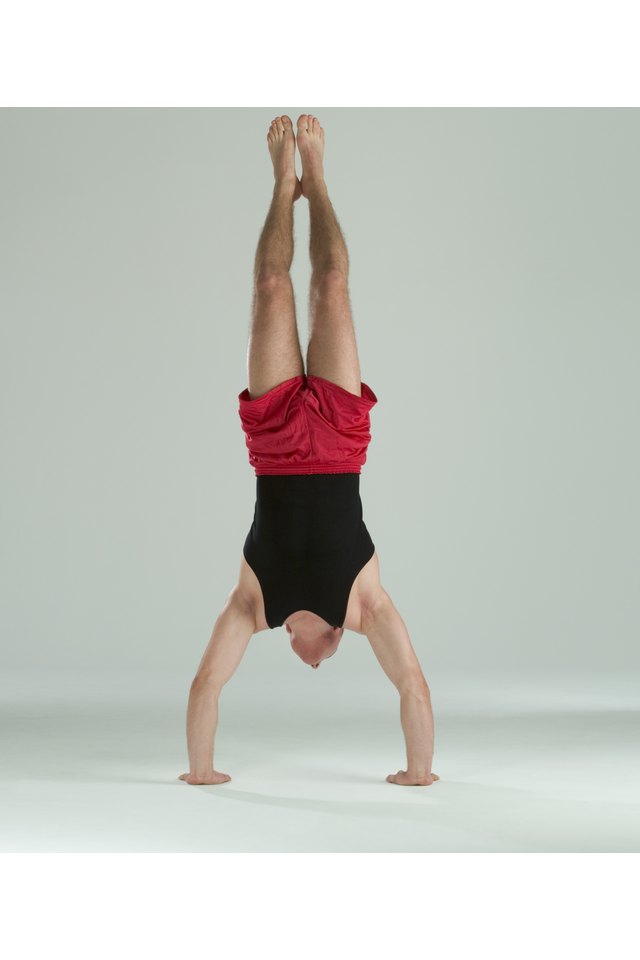What Do Guy Cheerleaders Do?

Cheerleading was invented in the 1880s at Princeton University, with one man leading the crowd of spectators in unified yells and chants which he termed "cheers." Soon, "pep clubs" became popular in many colleges and universities around the United States. Cheerleading became a recognized, all-male activity and remained all-male for 25 years. The first female cheerleaders emerged in the 1920s, but the sport remained male-dominated. That changed in the 1940s, when young men were called off to war and young women joined cheerleading clubs to fill the vacancies left behind. By the 1960s, the addition of gymnastics and stunting to cheerleading routines brought a need for strong athletes on cheerleading teams. In the 1980s cheerleading competitions gained popularity. Many university teams strove to recruit male members who provided strength, power and a much needed competitive edge. That continues to be the case today.
Group Stunts
Stunting requires a great deal of upper body strength. Male cheerleaders are known for providing the strength necessary to make stunt groups more successful and increase the level of skills which can be executed. For example, at United States All Star Federation Level 6, which requires all athletes on the team to be 17 years of age or older, it is legal to stack pyramids up to 2.5 persons high. An example of this stunt is a 2-2-1, where two stunt groups hold their flyers, facing in, at prep level and a third flyer is placed in the hands of those flyers and held waist high. The bases supporting this stunt are lifting the weight of approximately one and a half persons. These bases must have exceptional upper body strength. Males, in general, are known to possess a high level of upper body strength, and without male cheerleaders, it is unlikely that a team would be able to execute such skills.
Partner Stunts
Partner stunts are stunts where a single base is responsible for lifting the entire weight of his flyer on his own. This requires an enormous amount of strength, mostly in the upper body and legs. While girls may base other girls in partner stunts, it is more often male cheerleaders who hold a flyer in the air during partner stunting. In addition to strength, it is a skill which requires balance, confidence and control. Partner stunting is one of the most difficult aspects of cheerleading to learn and often takes years of training to master.
Basket Tosses
Basket tosses are the skill most likely to amaze an audience. In a basket toss, the flyer is thrown up to 18 feet into the air where she executes a skill or position, for example a toe touch, before coming down to be caught in a cradle. Baskets increase in difficulty as they increase in USASF level. By level 5, a flyer is expected to complete a kick followed by two full twists before landing in the cradle. The higher a basket is thrown, the more time a flyer has to execute a number of skills. Guy cheerleaders have the upper body strength to add the explosive power and ensure high baskets.
Tumbling
Floor gymnastics skills, or tumbling, have become a vital part of cheerleading. Many cheerleading programs, whether university or all star, require their athletes to tumble to a high level for competition and performance. Mastering these skills takes full body strength. Male cheerleaders often have well-developed muscles not only in their upper body and chest, but also in their legs and abdominals. These muscles allow male cheerleaders to run into passes with power, push off the ground with good height and control their body positions while in the air. They are often quicker to learn new gymnastics skills than their female counterparts.
References
Resources
Writer Bio
An American writer living in the United Kingdom, Christy Mitchinson began writing professionally in 2000, during her career in laboratory science, pathology and research. She has authored training materials, standard operating procedures and patient/clinician information leaflets. Mitchinson is pursuing a Bachelor of Arts in English literature and creative writing with The Open University.
